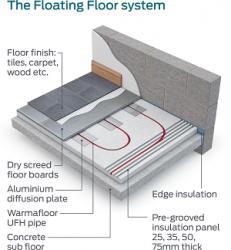The optimum heating solution for public sector buildings
 When considering heating options, public sector organisations have a lot to consider, juggling issues of cost, environmental impact, value for tax payers, maintenance and of course effectiveness in creating a comfortable environment.
When considering heating options, public sector organisations have a lot to consider, juggling issues of cost, environmental impact, value for tax payers, maintenance and of course effectiveness in creating a comfortable environment.
To help address these issues, the public sector is turning to underfloor heating (UFH) with dry floor construction as an alternative to traditional screed options. It is quick to install and, because it needs no drying time, the construction team can get straight on with the adjacent trades. This significantly reduces time spent waiting to apply a floor finish, and saving time means saving money.
Using dry floor construction UFH also enables a faster and more efficient response time, creating a constant ambient environment to ensure occupants are at their optimum comfort levels in all weather conditions. In schools for example, each classroom can control its own temperature – quickly and easily. Also, the same pipes that heat can also serve to cool a space. With the average national temperature predicted to rise by as much as 8°C over the next century, it makes sense for government businesses to fit buildings for the future and consider the implementation of comfort cooling from the outset
Environmentally, underfloor heating’s zero ozone depletion potential is another exceptional benefit. Because underfloor heating systems run at lower water temperatures, energy usage is significantly reduced, lowering the carbon footprint of the building. Warmafloor’s dry floor product is 100% recycled ensuring BREEAM requirements can be met.
For over 30 years, Warmafloor has been providing heating solutions to public sector organisations and, to date, some 1,300 schools benefit from Warmafloor’s expertise.
When it comes to maintenance, Warmafloor’s underfloor heating comes with an industry leading 100-year guarantee on its British Standards Kitemarked pipes. It is maintenance free. No maintenance costs, more money saved.
With regard to health, underfloor heating beats traditional radiator systems because it does not spread bacteria, allergens and dust like convection radiators, promoting better air quality and reducing the risk of condensation and microbiological growth.
It also frees up wall space, making room design much more flexible. No radiators means more wall space, a safer environment and more freedom to rearrange offices or classrooms.